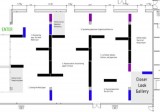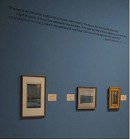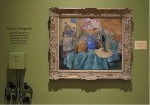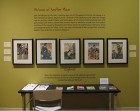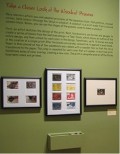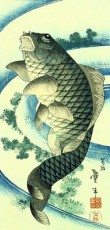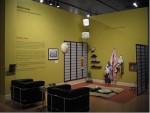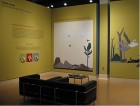The browser will either open the file, download it, or display a dialog.
The Orient Expressed: Japan's Influence on Western Art, 1854–1918
Mississippi Museum of Art, Jackson
February 19–July 17, 2011
McNay Museum of Art, San Antonio
October 5, 2011–January 15, 2012
Catalog:
The Orient Expressed: Japan's Influence on Western Art, 1854–1918.
Edited by Gabriel P. Weisberg.
With contributions by Petra ten-Doesschate Chu, Laurinda S. Dixon, Elizabeth K. Mix, Sarah Sik, and Erica L. Warren.
Seattle and London: Mississippi Museum of Art in association with the University of Washington Press, 2011.
192 pages; 168 color illustrations; list of exhibited works; bibliography; index.
$34.95
ISBN: 9781887422192
Published description from the Mississippi Museum of Art:
The Orient Expressed explores the cultural phenomenon known as Japonisme. First identified by French art critic Philippe Burty in 1872, Japonisme became a worldwide movement that deeply impacted the visual arts in the 19th and early 20th centuries. Among the works included are paintings by Paul Gauguin, Pierre Bonnard, Mary Cassatt, William Merritt Chase, and James McNeill Whistler as well as decorative pieces by Gorham Manufacturing Company, Rookwood Pottery, and Tiffany and Company.
The Orient Expressed is generous, varied, and splendid. Developed by the Mississippi Museum of Art in Jackson, and traveling to the McNay Museum of Art in San Antonio, Texas, the larger exhibition in Jackson includes two hundred objects—paintings, prints, drawings, ceramics, glass, furniture—that engage the exhibition’s theme in six distinct sections, set apart from one another by titles and wall colors. Well-chosen short quotes bring historic voices to the experience of discovery in each section (fig. 1). Three-dimensional delights abound, and numerous objects in the exhibition are gasp-worthy. Objects that stand out among numerous favorites: the suite of etchings by Félix Buhot; the bold blue-carp-on-white silk Japanese-made kimono that belonged to Longfellow’s son, Charles; the 1879 Tiffany copper coffeepot with sterling silver dragonflies on the body and lid; and a pair of Auguste Jean vases.
Over fifty institutions contributed works to the exhibition. Among these, the contributions of the New Orleans Museum of Art are particularly striking, for they include some of the most dramatic “accent” objects in the display, including Auguste Jean’s Vases and John Peter Alphonse Lejambre’s Parlor Cabinet, ca. 1870–1875, made of ebonized cherry with gilt, lacquer and silk velvet. Dan Piersol, Deputy Director of the Mississippi Museum of Art, developed his interest in Japonisme from John Keefe, decorative arts curator at the New Orleans Museum of Art, who was especially enthusiastic about the nineteenth century, his “beloved century.” Keefe died unexpectedly only two weeks before the Jackson exhibition’s opening. Given his love for the NOMA objects lent to the Jackson exhibition, and objects lent from his personal collection, The Orient Expressed is in some ways an epitaph for this recently departed curator.
Viewers entered the exhibition through a section called “Discovering Japan: West Meets East” which introduced the subject through a wall text and map about Commodore Matthew Perry’s sea route and the “opening” of Japan. Seven prints by Hiroshige II, Sadahide and others then introduced the theme of the encounter between Japan and the United States. As the wall color changed from ochre to tan, the visitor met the early enthusiasts of 'all things Japanese’: les frères Goncourt, recalled by Félix Bracquemond’s exquisite etched Portrait of Edmond de Goncourt (1882); Siegfried Bing, whose four covers from Le Japon Artistique represent the beautiful publication through which he offered an impressively illustrated education on the arts of Japan (1888–1891); and Félix Buhot’s suite entitled Japonisme: Dix Eaux-Fortes (1883). Their startling yellow paper was a special surprise because the prints were protected behind black drapes to be lifted by the gallery visitor.
The next section, “Seeing the Real Japan,” opens with another quote from the Goncourts as well as photographs, watercolors, prints, a screen, a fan, kimonos, groups of prints by Berthe Lum and Helen Hyde; and gatherings of works by Robert Frederick Blum and Charles Hovey Pepper. This section makes a strong impression thanks to a photograph of the Great Buddha at Kamakura and John LaFarge’s bold 1887 watercolor of the same subject. In addition, Charles Longfellow’s spectacular kimono features a dramatic printed black leaping carp and brilliant blue aquatic patterns on white silk (figs. 2, 3 and 4). The third section is called “Popularization: Assimilating Japan in France” (fig. 5). This expansive area displays consumer goods that convey vividly how prevalent the motifs from Japanese arts must have been in the art-conscious households of Paris. Tablewares and similar utilitarian objects from Sèvres, Escalier de Cristal, and Creil et Montereau join pieces from Félix Bracquemond’s famous Service Rousseau (1868) decorated with elements from Hokusai’s Manga. The ceramics are a feast for the eyes and included one of the most sumptuous objects in the exhibition, one of the Escalier de Cristal plates (Weisberg Collection, Minneapolis) from the table service called Japanese Fantasy (1885–90), in which a carp and a spritz of wave and foam animate two-thirds of a white scalloped-edge plate. A detail of this plate was enlarged to fill a page in the catalog facing the start of the key essay, and it is one of the most beautiful pages in a lovely catalog. Among the works new to me were three plates from the Service Kyoto, (ca. 1870), made by Creil et Montereau (Manières Collection, Paris). Against a pale turquoise background, each plate is decorated with a bordered white square cloth that serves as a field for a cluster of colorful shapes, with each plate incorporating a different design on the white field. In other well-lit cases, books and other objets evoke the range of media in which the taste for Japan met its audience. On the walls in this gallery, a dozen varied prints and posters diversify the experience. A display case of books is dominated by Louis Gonse’s L’Art Japonais (1883; fig. 6). Prints and posters give vivid evidence of Japan’s impact on designs for works on paper. High on the wall, the words of Raymond Needham, a critic who wrote about Japanese art and the poster in 1901, sum up the importance of Japanese design on the graphic arts of the West: “Take any representative Japanese print … and it will be found to embody all that a good poster should.”
In “Spreading Japonisme: England and America,” one is treated to a feast of familiar favorites from late nineteenth-century collections: Baccarat glass, Rookwood pottery, and Mary Cassatt’s suite of ten aquatints. Cassatt’s prints were hung closely together in a corner to be seen all at once, rather than single file. Nearby, the work of James McNeill Whistler, Arthur Wesley Dow, and three works by Louis Rhead delighted my companions in April, particularly Rhead’s imposing color lithographic mural, Swans (1897; Jane Voorhees Zimmerli Art Museum, New Brunswick, New Jersey) which depicts swans plying stylized ripples among water lilies and iris. A petite brass table attributed to Bradley & Hubbard of Meriden, Connecticut (1880s; Birmingham Museum of Art, Alabama; not illustrated in the catalog) is set at an angle near the end of the gallery in handsome juxtaposition with delicate works on the near wall (figs. 7, 8, 9, 10, 11 and 12).
The area called “La Femme: Women, Fashion, and Japonisme,” contains an array of beautiful objects surrounded by depictions of women dressed in kimono or admiring Japanese art. This gallery conveyed the emphatically feminine orientation of Japonisme. In addition to oil paintings by William Merritt Chase, Thomas Wilmer Dewing, Alfred Stevens, Robert Henri, Charles Sprague Pearce, and Gustave Leonard de Jonghe, the visitor is treated to one of Whistler’s tiny painted figures with flowers and fans, Sketch of a Figure (1867–79; Maier Museum of Art, Randolph College, Lynchburg, Virginia), Philip Leslie Hale’s beautiful pastel Lady with a Fan (ca. 1914; Columbus Museum, Georgia), and Henry Somm’s watercolor, L’Elégante Japonaise (ca. 1880s; Honolulu Academy of Arts, Hawaii) (figs. 13, 14, 15 and 16).
Section 6 is entitled “Owning Japonisme: The Still Life” and brings together seven remarkably varied and substantial still lifes that make for a satisfying final gallery after the energy and drama of the preceding spaces. Paintings by James Ensor, Paul Gauguin, Chase, and Elihu Vedder depict Asian objects gathered with objects that are usual to the genre. Visitors were most struck by Catherine Bissell’s trompe l’oeil canvas, Lemons and Lace (1894; Birmingham Museum of Art, Alabama) in which the straightforward format of objects aligned on a shelf parallel to the picture plane dramatizes the contrast of the crisply rendered lace with the work’s dark background (fig. 18). Gauguin’s words about the collected sources in his Tahitian hut punctuate a wall in the last area of this section (figs. 18 and 19).
“The Orient Expressed” offers the experience of a generous and satisfying range of Western works, complemented by the display of a few ukiyo-e prints, which occupy “bookend” positions in the exhibition. The exhibition’s final section, a modest coda called “Pictures of Another Place,” reminded the visitor of the role played by ukiyo-e prints in the development of Japonisme (fig. 20). Reference books are available here, and on a facing wall, didactic sample blocks and prints by Stephen D. Cook, Associate Professor of Art at Mississippi College, offer a tactile acquaintance with the steps of woodblock printmaking that generate its appealing directness (figs. 21 and 22).
This vignette about woodblock printmaking is one of numerous interactive components that engage the visitor throughout the exhibition. Some of these are clearly for children, from a felt-board wall of shapes inviting the construction of a landscape in flat forms; to bright red and yellow hinged wooden wall fans that pose questions; to headphones offering commentaries on complex topics, such as the method by which Félix Bracquemond transcribed elements from Hokusai’s Manga to paper and pressed fresh etching impressions onto ceramic bodies for glazing (figs. 23 and 24). The recordings disencumber the labels, which are compact throughout the exhibition.
Stepping beyond the exhibition’s “Closer Look at the Woodcut Process,” one walks among slender pillars wrapped in the painted photographs of Mississippi-born artist Randy Hayes, whose Kyoto Views, inspired by a recent trip to the historic city, offer a contemporary example of the renewed fascination of the West with Japan’s art and people. As Hayes said in the catalog press release: “The strongest influence on this series as it progressed was the hashira-e or pillar print. . . . Hung from the support post, or pillar, of the traditional Japanese home, these prints were exceptionally tall and narrow. I have based several recent works on this concept.”
Enthusiasts of Japonisme who see The Orient Expressed will consider the coincidence of the exhibition with the triple disasters of earthquake, tsunami, and reactor failure that afflicted Japan last spring; visitors to the exhibition in Jackson were also invited to make contributions for Japan relief.
Catalogue
The catalog for The Orient Expressed is a handsome publication, extensively illustrated, which functions both as a record of the exhibition and as an independent contribution to scholarship on the topic of Japonisme. As such, it joins a list of seminal studies including exhibition catalogs authored by Phillip Dennis Cate, Phylis Floyd, Colta Feller Ives, and guest curator Gabriel Weisberg, whose 1975 catalog for The Cleveland Museum of Art’s Japonisme exhibition introduced the topic with an impressive range of material.
Whereas the exhibition offers the viewer six vantage points from which to see and grasp the impact of Japanese art on the art of the West, the catalog explores the dynamics of cultural exchange and delves into additional manifestations of Japonisme. For this reason, the catalog will stand both as a record of the exhibition, and as a volume whose written content establishes new lines of inquiry in the study of the impact of Japan.
Gabriel Weisberg, curator of the exhibition, contributed “Rethinking Japonisme: The Popularization of a Taste.” In his essay, he acquaints newcomers with this subject, organized in a form that is readily relatable to the Jackson installation. He touches on all facets of the exhibition, from the origins of Japonisme to its popularization beyond France. In addition, his intended “fresh look” at Japonisme includes a discussion of the special place of women in the imagery of Japonisme as well as women’s role in its dissemination. Illustrations work into the topic important artists who are not represented in the exhibition such as James Jacques Tissot.
Laurinda Dixon’s essay on “Trade and Tradition: Japan and the Dutch Golden Age” provides background to the so-called “opening” of Japan that Perry achieved in the mid-nineteenth century, and paints a picture of cultural exchange in the two centuries before that event. The developments in the production of tableware and their impact on the pottery industry of Delft are parts of the story of the West’s longstanding desire to buy and sell the exotic goods of the East. Enthusiasts of Jan Vermeer are rewarded by Dixon’s discussion of the loose garment in which Vermeer dressed his Geographer. Called a “rock,” and then a “Japon,” this padded kimono was worn by privileged officials and scholars.
Petra Chu’s essay, “Chinoiserie and Japonisme” contributes to a better understanding of the varieties of enthusiasm for Chinese art and the varieties of exotic objects and qualities that figure in the Western artistic response to the arts of the East. She reviews the idea that the adoption of the qualities of Japanese art, such as the bold lines, flat color, and asymmetrical compositions of ukiyo-e prints, followed an earlier phase of more elementary borrowing, such as the inclusion of exotic objects in otherwise Western pictures, and finds this understanding to be simplistic. Rather, she suggests that: “Our understanding of cultural exchange today calls for a much more complex process, in which flirtation with the exotic aspects of 'other’ arts and cultures. . . serves. . . as a constant inspiration to artistic innovation and originality” (103).
“’Those Naughty Little Geishas:’ The Gendering of Japonisme” by Sarah Sik addresses characteristics and intentions in the Japoniste work of women artists Helen Hyde, Bertha Lum, and Mary Cassatt as a prelude to a discussion of the central roles of women as both subjects and consumers of Japonisme. One section of her essay brings together the ubiquitous fan in later nineteenth-century art and accessories of the elegant woman; and another surveys the impact of geisha imagery as an agent of fantasy in the West.
In the essay entitled “Japonisme and Cultural Appropriation,” Elizabeth Mix demonstrates that “appropriation. . . has, in fact, a long and complicated history,” and is not a postmodern practice only (127). She gives transcultural exchange a context in nineteenth-century romanticism as well as in the attraction of Asian religions and the Eastern reverence for nature in a period of anxiety. In the discussion of specific examples, she gives useful attention to the sophisticated imagery of Henry Somm, which belongs to a different order of appropriation than that of Vincent van Gogh. Her essay includes comments on the ironic appropriations of artists, such as Akiro Kurosawa, and the commodification of cultures by the West, a theme of contemporary artist Yasumasa Morimura.
Erica Warren’s essay, “Japonisme and Scandinavia,” is the most provocative, articulating the nationalist uses to which Japonisme may have been put in the evolution of a specifically Norwegian modern art. Warren sees Japoniste features in the works of several Norwegians in the early life of the young nation; the key figure of her essay, Gerhard Munthe, employed Japoniste flatness as the style for his depiction of subjects from Norwegian folktales (The Three Brothers, 1908, weaving, Vesterheim Norwegian-American Museum, Decorah, Iowa) to craft a nationalist art that was ancient in content, but modern in style.
The Mississippi Museum of Art created an optimal environment for The Orient Expressed, and the spacious galleries made for an unhurried, tranquil, and satisfying experience. For general audiences, the exhibition was a valuable eye-opening introduction to the beautiful world of art and objects that resulted from the West’s enthusiasm for the arts of Japan, from the 1860s through World War I. Inclusion of the Longfellow kimono helped such visitors to imagine that Japonisme was not a narrow academic specialty, but a broad cultural phenomenon; and inclusion of works by artists such as Whistler and Cassatt, whom American art museum-goers feel they know, served to demystify Whistler’s spare, asymmetrical landscapes and deepen appreciation for Cassatt’s prints and their elevated vantage points. For students of the West in the nineteenth century, the exhibition offered a satisfyingly rich display of two-and three-dimensional works that felt full and comprehensive, yet manageable. I especially appreciated the glass and ceramic objects, and the chance to become more familiar with Louis Rhead, Félix Buhot, Helen Hyde and Bertha Lum. The catalog achieved a balance between exhibition record and new scholarship that makes it a valuable addition to the bibliography on Japonisme.
Karen Pope
Allbritton Art Institute, Baylor University
karen_pope[at]baylor.edu


